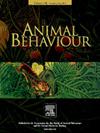Brown-headed cowbirds select nests to parasitize based on individual host attributes rather than nest type
IF 2.3
2区 生物学
Q2 BEHAVIORAL SCIENCES
引用次数: 0
Abstract
Choosing nests of appropriate hosts is crucial to the success of obligate avian brood parasites because they rely on these hosts to care for their young. Female brood parasites may choose nests by imprinting on the habitat in which they were born, parasitizing nests randomly within their natal habitat, parasitizing a specific nest type or imprinting and preferring a specific host species. We took advantage of our system of nestboxes to conduct the first study on how female brown-headed cowbirds, Molothrus ater, decide which nests to parasitize by testing the nest site and host preference hypotheses. First, we tested cowbird host selection using a paired nestbox experiment with the prothonotary warbler, Protonotaria citrea. One nestbox had an entrance large enough for warblers and cowbirds to enter, while the second box had an entrance that only allowed warblers to enter. Cowbirds only parasitized nestboxes containing warblers and when warblers used nestboxes with small entrances, the cowbirds attempted to lay in those boxes instead of laying in the paired boxes with larger entrances that contained dummy eggs, indicating a preference for the host rather than the nest site. Second, we monitored cowbird host choice within the cavity-nesting community to ascertain whether cowbirds choose hosts based on nest type and use nestboxes at an equal rate (the nest site hypothesis) or whether they select specific hosts within the nestboxes (the host preference hypothesis). Cowbirds never parasitized inactive nestboxes and parasitized prothonotary warblers significantly more frequently than northern house wrens, Troglodytes aedon, and tree swallows, Tachycineta bicolor. Our results support the host preference hypothesis that brown-headed cowbirds choose nests to parasitize based on the individual attributes of hosts, although they may use additional cues such as the nest structure within the cavities and appearance of host eggs.
褐头牛鹂根据个体寄主的属性而不是巢的类型来选择寄生的巢
选择合适的寄主巢穴对于专性鸟类寄主的成功至关重要,因为它们依赖这些寄主来照顾它们的幼鸟。雌性寄主可以通过在其出生的栖息地上留下印记、在其出生的栖息地随机寄生、寄生于特定的巢型或印记并偏爱特定的寄主物种来选择巢穴。我们利用我们的巢箱系统,通过测试巢位和寄主偏好假设,首次对雌性褐头牛鹂(Molothrus ater)如何决定寄生巢穴进行了研究。首先,我们用配对的巢箱实验测试了牛鹂与原翅莺的寄主选择。其中一个鸟巢的入口大到足以让莺和牛郎鸟进入,而另一个鸟巢的入口只允许莺进入。牛郎鸟只寄生在有莺的巢箱里,当莺使用有小入口的巢箱时,牛郎鸟试图在这些盒子里产卵,而不是在成对的、有大入口、有假蛋的盒子里产卵,这表明它们更喜欢宿主,而不是筑巢地点。其次,我们监测了燕八哥在洞巢群落中的寄主选择,以确定它们是根据巢型选择寄主,并以相同的频率使用巢箱(巢址假说),还是在巢箱中选择特定的寄主(寄主偏好假说)。牛鹂从不寄生于不活跃的巢箱,而寄生于原翅莺的频率明显高于北方鹪鹩、穴居鹩和树燕。我们的研究结果支持寄主偏好假说,即褐头牛鹂根据寄主的个体属性选择巢寄生,尽管它们可能会使用其他线索,如巢腔内的巢结构和寄主卵的外观。
本文章由计算机程序翻译,如有差异,请以英文原文为准。
求助全文
约1分钟内获得全文
求助全文
来源期刊

Animal Behaviour
生物-动物学
CiteScore
4.60
自引率
8.00%
发文量
236
审稿时长
10.2 weeks
期刊介绍:
Growing interest in behavioural biology and the international reputation of Animal Behaviour prompted an expansion to monthly publication in 1989. Animal Behaviour continues to be the journal of choice for biologists, ethologists, psychologists, physiologists, and veterinarians with an interest in the subject.
 求助内容:
求助内容: 应助结果提醒方式:
应助结果提醒方式:


